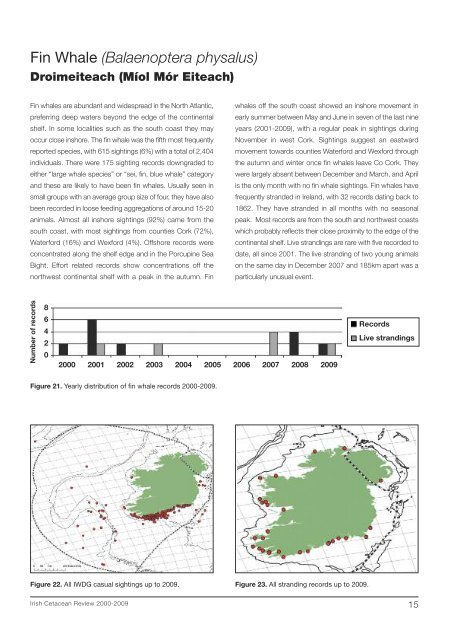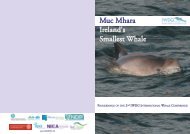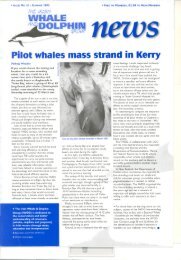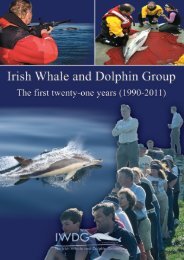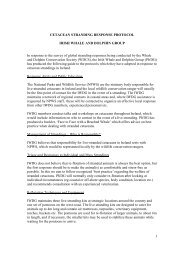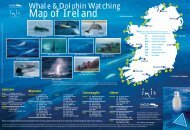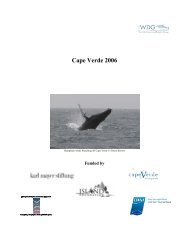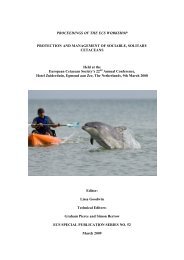downloaded here - Irish Whale and Dolphin Group
downloaded here - Irish Whale and Dolphin Group
downloaded here - Irish Whale and Dolphin Group
Create successful ePaper yourself
Turn your PDF publications into a flip-book with our unique Google optimized e-Paper software.
Fin <strong>Whale</strong> (Balaenoptera physalus)<br />
Droimeiteach (Míol Mór Eiteach)<br />
Fin whales are abundant <strong>and</strong> widespread in the North Atlantic,<br />
preferring deep waters beyond the edge of the continental<br />
shelf. In some localities such as the south coast they may<br />
occur close inshore. The fin whale was the fifth most frequently<br />
reported species, with 615 sightings (6%) with a total of 2,404<br />
individuals. T<strong>here</strong> were 175 sighting records downgraded to<br />
either “large whale species” or “sei, fin, blue whale” category<br />
<strong>and</strong> these are likely to have been fin whales. Usually seen in<br />
small groups with an average group size of four, they have also<br />
been recorded in loose feeding aggregations of around 15-20<br />
animals. Almost all inshore sightings (92%) came from the<br />
south coast, with most sightings from counties Cork (72%),<br />
Waterford (16%) <strong>and</strong> Wexford (4%). Offshore records were<br />
concentrated along the shelf edge <strong>and</strong> in the Porcupine Sea<br />
Bight. Effort related records show concentrations off the<br />
northwest continental shelf with a peak in the autumn. Fin<br />
whales off the south coast showed an inshore movement in<br />
early summer between May <strong>and</strong> June in seven of the last nine<br />
years (2001-2009), with a regular peak in sightings during<br />
November in west Cork. Sightings suggest an eastward<br />
movement towards counties Waterford <strong>and</strong> Wexford through<br />
the autumn <strong>and</strong> winter once fin whales leave Co Cork. They<br />
were largely absent between December <strong>and</strong> March, <strong>and</strong> April<br />
is the only month with no fin whale sightings. Fin whales have<br />
frequently str<strong>and</strong>ed in Irel<strong>and</strong>, with 32 records dating back to<br />
1862. They have str<strong>and</strong>ed in all months with no seasonal<br />
peak. Most records are from the south <strong>and</strong> northwest coasts<br />
which probably reflects their close proximity to the edge of the<br />
continental shelf. Live str<strong>and</strong>ings are rare with five recorded to<br />
date, all since 2001. The live str<strong>and</strong>ing of two young animals<br />
on the same day in December 2007 <strong>and</strong> 185km apart was a<br />
particularly unusual event.<br />
Number of records<br />
8<br />
6<br />
4<br />
2<br />
0<br />
2000 2001 2002 2003 2004 2005 2006 2007 2008 2009<br />
Records<br />
Live str<strong>and</strong>ings<br />
Figure 21. Yearly distribution of fin whale records 2000-2009.<br />
Figure 22. All IWDG casual sightings up to 2009. Figure 23. All str<strong>and</strong>ing records up to 2009.<br />
<strong>Irish</strong> Cetacean Review 2000-2009<br />
15


